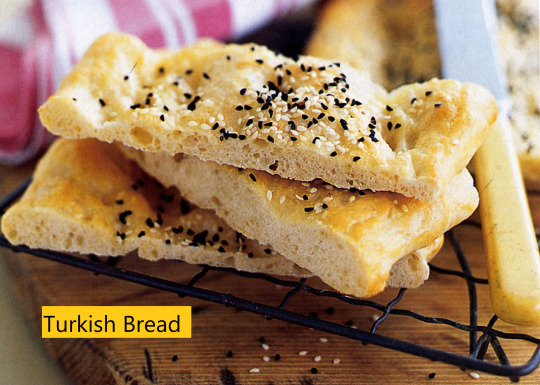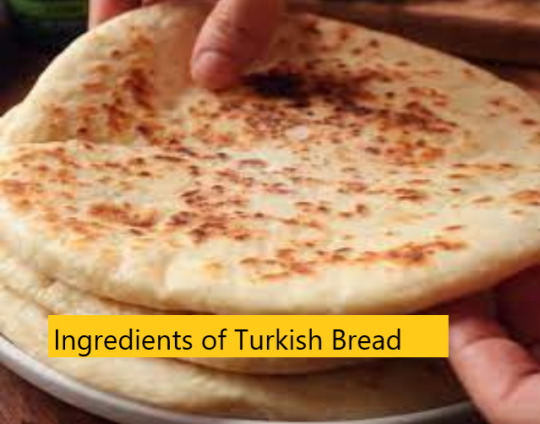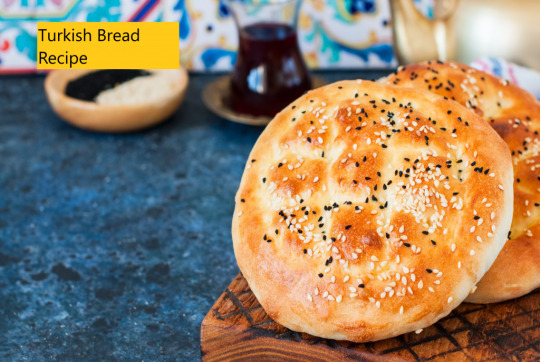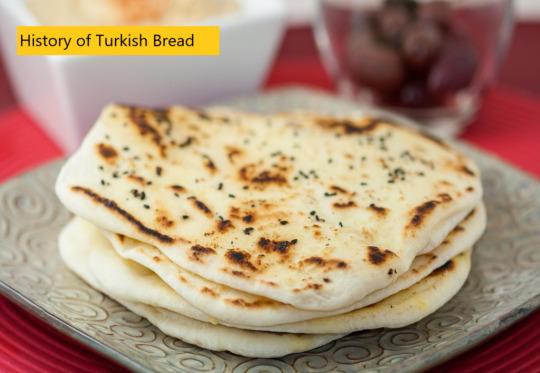#BreadItems
Explore tagged Tumblr posts
Text
How to make Turkish Bread? Easy and Simple Recipe in 2022

Turkish bread known as bazlama is comparable to naan bread from India. With just a few basic ingredients that are sure to be in your cupboard, it is tasty and pillowy soft. a quick and simple pita recipe that produces fluffy bread. Simplest bread recipes available! Your family and friends will be impressed by this flatbread dish. For the ideal snack, spread some butter or oil on this handmade pita bread and dunk it in hummus.
Turkish Bread
When we used to reside in North-East London close to a Turkish bakery, we became dependent on it. They offered these incredible fresh-from-the-oven Turkish loaves for 80p each, and the tantalising aroma made it impossible to pass without purchasing some. Even a day or two later, when cut into thin strips and lightly fried on a griddle pan, it tastes fantastic. It is best served with a variety of mezze dishes for dipping.

Turkish Bread This Turkish flatbread is the fluffiest and only requires one proofing to be completed. It can be prepared on the stovetop in a non-stick pan without the need for baking. You can prepare it for breakfast, lunch, or simply a holiday gathering to welcome your loved ones. Now that we don't reside in London anymore, I have to prod Duncan into occasionally making us Turkish bread. Being one of the simplest breads you'll ever make, he is actually not that resistive to it.
Ingredients of Turkish Bread
These are very basic basics that you undoubtedly already have in your cupboard. Since this is a wonderful and simple recipe for all bread lovers, you don't need anything extravagant. This is great for everyone because you can make it without any prior baking knowledge. - All-purpose flour should be used to prepare this loaf. There is no special flour required. You only have the bare necessities in your kitchen cabinets. However, we advise using unbleached flour. We never use flour that has been bleached. - You will require one packet of dry yeast. Each packet must weigh 7-8 grammes. Basically, this recipe only requires a basic small yeast tablet. - Oat Milk: While we advise using oat milk for this recipe because it gives the Turkish bread a maltier flavour, you can substitute any other plant-based milk. Almonds, coconut, and even soy milk all work well. There's no need to go shopping; all you need is the plant-based milk you already have in the refrigerator. - Olive oil: For this recipe, you'll need a few tablespoons of olive oil, plus a little extra to brush over the Turkish bread when it's done. Although we insist on using olive oil in all of our recipes, you are welcome to substitute any other vegetable oil. There is no need to worry because it won't ruin the recipe. - Sea salt is a need for this dish. Without salt, Turkish bread does not taste nice. - For this recipe, I like to add parsley and cilantro (coriander). They complement Turkish bread's flavour the best. Delicious! - Another thing? You can optionally add chilli flakes, but I prefer to exclude them because my husband doesn't like spicy cuisine.

Turkish Bread Take these ingredients - 250 g / 2 cups bread flour - 7 g / 0.25 oz / 2¼ tsp instant dried yeast - 200 ml / ¾ cup + 4 tsp warm water - 2 tsp caster/fine sugar - 1 tsp fine salt - 15 ml / 1 tbsp olive oil, for glazing - handful of white and black sesame seeds
Turkish Bread Recipe
https://youtu.be/o9o81fJn3FQ In a big basin, combine the salt, sugar, and flour. The yeast should be placed in a tiny well you've made in the centre of the flour. Then, using your hands, combine everything after adding the water to the well. The dough should be quite wet and challenging to work with at this point. Wrap cling film around the mixing bowl and let it proof for approximately one hour (or until it has doubled in size). To prevent sticking, sprinkle enough of flour on a work surface before dumping the proved dough on it. the dough into a circle that is flat (about 2-3 cm high). The dough on a baking sheet that has been greased with olive oil. For an additional 45 minutes, cover the dough with a tea towel and let it proof. In the final 20 minutes, preheat the oven to 250° C / 480° F. Make a rough inner circle with your fingertips that is about 3 cm from the edge of the loaf before making a dent in the dough's top. Next, draw diagonal lines that are crisscrossed in the centre of the inner circle, spacing them about 2-3 cm apart (see 2nd picture in this recipe to get the idea).

Turkish Bread Apply olive oil with a pastry brush to the bread's surface. Sprinkle the bread with black and white sesame seeds, pressing them into the bread as deeply as you can to ensure that they stay there. Turn the oven down to 200° C/ 390° F and bake the bread for an additional 5 minutes after baking it for 8 minutes at 250° C/ 480° F. (or until golden brown).
Tips for Turkish Bread
- Instead of milk, use plain, unsweetened yoghurt to make the dough. This will soften and enhance the flavour of the bread. - The dough should have a very soft consistency. The dough will initially seem moist and sticky, but as soon as you add a little oil, it will start to come together. Your flatbread will resemble a pizza base if your dough is dry and hard, funny! - Don't continue to knead the dough after it has fermented and expanded. The flatbreads would produce softer results and there would be minimal gluten production. - Make sure there are no holes or cracks in the dough when you roll it out or make the dough balls; otherwise, the flatbread won't puff up. - Prior to cooking the bread, make sure to heat the pan on medium-high for 5 minutes. Low heat will cause your bread to not rise very well.

Turkish Bread - As soon as the flatbread removes from the pan, be sure to cover it in a cloth. This will keep them cosy and supple. - Instead of making 8 small loaves, make 2 large loaves: Large Turkish pide bread is also a typical dish. To do this, divide the dough into two pieces rather than eight and follow the recipe's instructions. The top should be brown after 20 to 25 minutes of baking at 400°F. - When pide comes out of the oven, it must be covered with a wet paper towel to keep it moist. - Sprinkle the bread with a very small amount of water, then reheat it for 5 to 10 minutes at 250°F in the oven. - Make careful to coat the dough balls so that rolling out the dough will be much simpler. The dough doesn't need to be rolled out using a rolling pin.
Other Turkish Bread Recipe
- Combine the flour, yeast, warm water, and oat milk in a large bowl. - When you have a smooth dough, add the salt and olive oil and begin to knead. It will take ten to fifteen minutes. - The smooth dough should be placed in a lightly oiled basin, covered with a moist cloth, and left to rise for 45 to 60 minutes in a warm location. - Place the dough on your work area after lightly dusteding it with flour. Make eight cuts in the dough. - On the stove, preheat a nonstick frying pan (stove). - A piece of dough should be rolled into a circle and cooked in the pan for two to three minutes on each side. Use the remaining flatbreads in the same manner. - Sprinkle fresh herbs on top of your baked flatbread after brushing it with a little olive oil. Is Turkish bread healthy?Turkish bread is equally as nutritious as other bread. The same ingredients used to make regular bread are used to make this bread.What are Turkish breads called?Turkish cuisine heavily relies on bread, and there are numerous varieties of Turkish bread. Pide Ekmek, Ramazan Pidesi, Msr Ekmei, Pita bread, Yufka, Bazlama, Simit, and Gözleme are a few popular examples.What is different about Turkish bread?Turkish bread generally isn't any different; it just depends on the kind of bread you're baking. Turkish bread can range from pita bread to loaves that resemble foccaccia, as well as soft or crispy Turkish flatbread.
How to eat Turkish Bread?
Any food that pairs nicely with bread is a fantastic match for this Turkish bread. My personal favourites include the following: - For breakfast, serve with Menemen (Turkish Shakshuka), a Stovetop Frittata, or whipped butter or feta. - As a side dish with soup, particularly chicken and lentil soup - It tastes great dipped in hummus or acili ezme with a meze platter. - As a side dish for baked chicken drumsticks, moussaka, or lamb chops at dinner
History of Turkish Bread
The Oxford English Dictionary records that the word was first used in English in 1936. The English word is derived from Modern Greek (pta, "bread, cake, pie, pitta"), which in turn comes from Byzantine Greek (attested in 1108). For the gloss, it may also come from Ancient Greek (ptta) or (pssa), both of which mean "pitch/resin," or from (pikt), a type of fermented pastry that may have made its way to Latin as picta, similar to pizza. As Old Arabic's /p/ changed into /f/, it became fatteh in Levantine Arabic. Some theories link the word to the Classical Hebrew word (patt, lit. "a morsel of bread"). It is spelt similarly to the Aramaic letter pitt, which was borrowed into Byzantine Greek (see above). There are additional theories of Germanic or Illyrian middlemen.

Turkish Bread Turkish has adopted the word as pide, and it also appears in the Balkan languages as Bosnian-Serbian-Croatian pita, Romanian pită, Albanian pite, and Bulgarian pitka or pita; however, the word is used for burek-style pastries in the Serbo-Croatian languages of the nations that make up the Former Yugoslavia. The majority of pitas are baked at temperatures between 450 and 475 °F (232-246 °C), which causes the water in the dough to turn into steam and cause the pita to puff up and form a pocket. The pita can be opened to create a pocket because the layers of baked dough are still distinct inside the deflated pita after it has been taken out of the oven. Pita can, however, occasionally be baked without pockets and is referred to as "pocket-less pita." Pita is only proofed for a very brief period of time—just 15 minutes—regardless of whether it is made at home or in a commercial bakery. Do follow our facebook page Read the full article
#Bread#BreadItems#Dryyeast#FreshHerbs#HowtoeatTurkishBread?#IngredientsofTurkishBread#IsTurkishbreadhealthy?#OatMilk#Oliveoil#Pizza#starbucks#TurkishBread#TurkishBreadRecipe#TURKISHPIDEBREAD
2 notes
·
View notes
Link
Description:Brand:Giggle BreadItem: Ice Cream SquishySize: About 12cmScented: Yes; SweetRising Time: 8+ SecondsMaterial: PU FoamPackaging: Color Bag (Resealable) Note:It is NOT ...
0 notes
Photo

ΠΟΛΥΣΠΟΡΟ ΜΕ ΚΟΥΡΚΟΥΜΑ ΚΑΙ ΚΑΠΝΙΣΤΟ ΜΠΟΥΚΟΒΟ
Τα οφέλη του κουρκουμά στην υγεία μας είναι αδιαμφισβήτητα. Εμείς το συνδυάζουμε με καπνιστό μπούκοβο, σπασμένο λιναρόσπορο, κολοκυθόσπορο, ηλιόσπορο και παπαρουνόσπορο δημιουργώντας ένα ψωμί superfood!
Η δική μας εκδοχή του super food!

Τα οφέλη του κουρκουμά στην υγεία μας είναι αδιαμφισβήτητα. Αυτή η χρυσή ρίζα είναι γνωστή για την αντικαρκινική της δράση: μεταξύ άλλων είναι αντιφλεγμονώδης, βοηθά στην πρόληψη των κρυολογημάτων και της καταρροής, μειώνει τα επίπεδα του σακχάρου στο αίμα και προστατεύει τις αρθρώσεις μας. Στο ψωμί μας τον συνδυάσαμε με καπνιστό μπούκοβο πιπεριάς Φλωρίνης, που καπνίζεται σε ξύλα οξιάς. Για να ενισχύσουμε ακόμα περισσότερο τα οφέλη αυτού του ψωμιού στην υγεία μας, το εμπλουτίσαμε με λιναρόσπορο, γνωστό για το Ω3 που παρέχει στον οργανισμό μας, κολοκυθόσπορο, ηλιόσπορο και παπαρουνόσπορο, σπόρους που αποδεδειγμένα κάνουν καλό στον οργανισμό μας και δημιουργούν αίσθημα πληρότητας και ευεξίας. Όλα αυτά σε ένα ψωμί με τα κλασικά βιολογικά άλευρα της οικογένειας Παπαγεωργίου, αλεσμένα στο δικό τους πετρόμυλο, διατηρώντας έτσι όλες τις βιταμίνες και φυτικές ίνες του σιταριού. Η δική μας πρόταση για όποιον ενδιαφέρεται να φάει υγιεινά και να ελέγξει το βάρος του. Αξίζει να το δοκιμάσετε!
0 notes
Photo

ΚΑΡΒΕΛΙ ΜΕ ΧΑΡΟΥΠΑΛΕΥΡΟ ΚΑΙ ΚΑΡΥΔΙ
Φυσικά πλούσιο σε ασβέστιο και αντιοξειδωτικά και με μεγάλη περιεκτικότητα σε πρωτεΐνες και φυτικές ίνες, το χαρούπι αποτελεί τη νέα επιλογή που συνδυάζει τη γεύση με την υγιεινή διατροφή.
Το φτιάχνουμε σε μικρό καρβέλι και εκτός από χαρουπάλευρο Κρήτης προσθέτουμε αλεύρι σίτου λευκό και ολικής άλεσης. Τα καρύδια δίνουν ένα τόνο χειμώνα σε αυτό το ψωμί, που έγινε γρήγορα το αγαπημένο μας!

Μπορείτε να το δοκιμάσετε με το φαγητό σας, με αλμυρά τυριά ή ακόμα και σκέτο.
0 notes